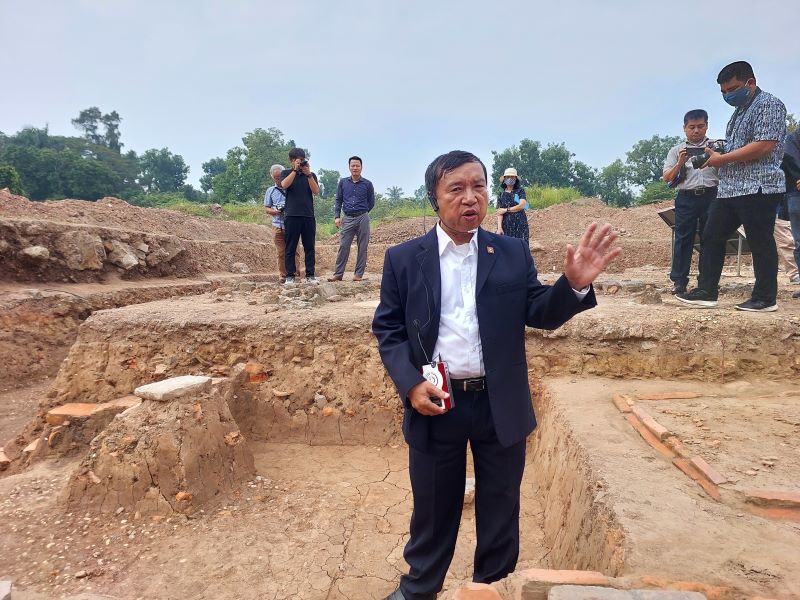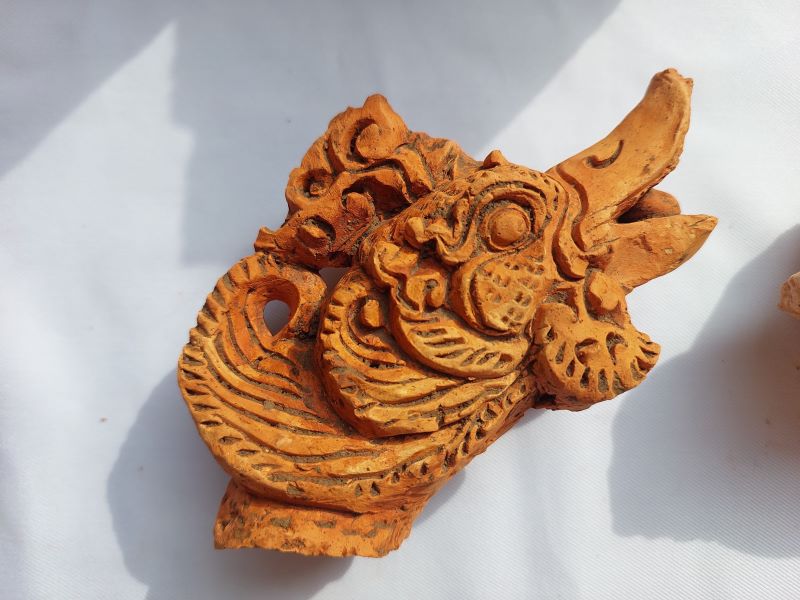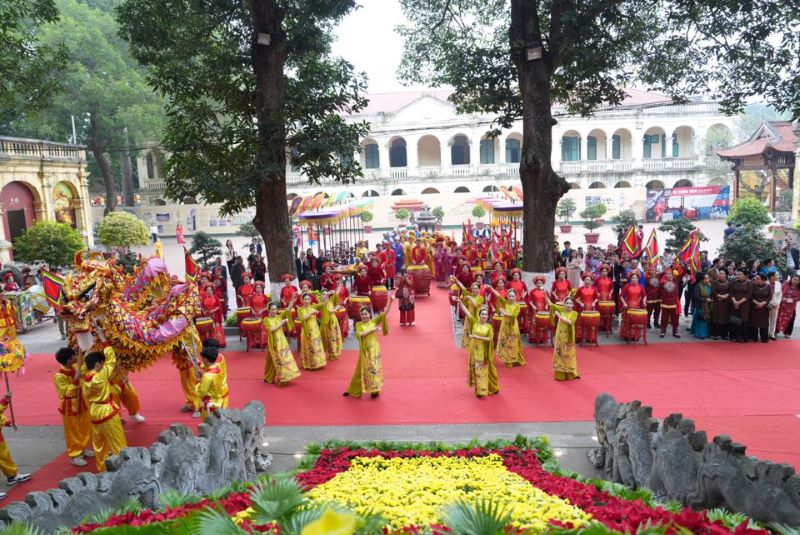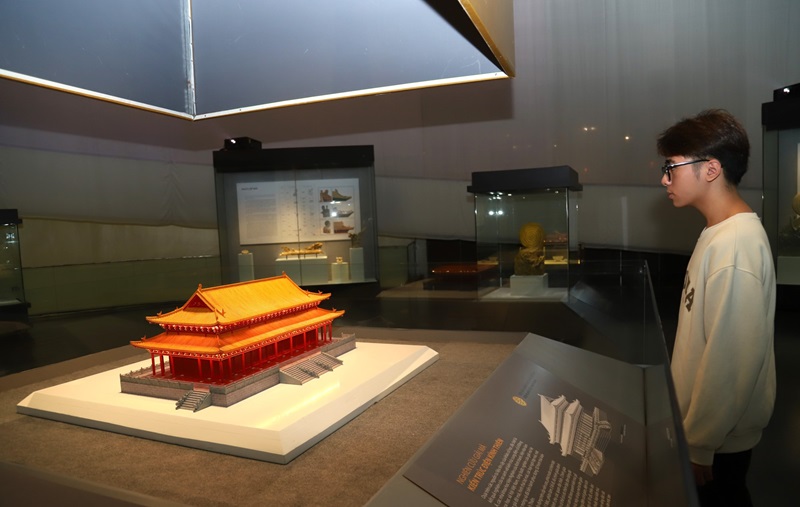The restoration of the Kinh Thien Palace, a significant site where Vietnam’s feudal courts once held court, is an extensive undertaking that has involved archaeologists and specialists for decades. This palace, located in the center of the Forbidden Citadel of the Thang Long capital during the Initial Le Dynasty, played a crucial role in hosting solemn rituals, receiving foreign diplomats, and discussing state affairs.
Unraveling the Mysteries
 |
| The latest excavation results provide a clearer understanding of the Kinh Thien Palace. Assoc. Prof. Dr. Tong Trung Tin, Chairman of the Vietnam Archaeological Association, elucidates these new findings. Photo: Tra My |
At the 46th session of the UNESCO World Heritage Committee in July, Vietnam’s proposals on the direction and vision for the research, conservation, and development of the World Heritage Site of the Central Sector of the Thang Long Imperial Citadel were accepted. The committee commended Vietnam for fulfilling all commitments made by the government since the site’s inscription in 2010. With the approval of the conservation and enhancement dossier, the Zodiac Axis can now be opened up, paving the way for the restoration of the Kinh Thien Palace.
This restoration project aims to decipher the architectural secrets of the palace and elucidate the scientific value of the archaeological discoveries. Since 2011, the Thang Long – Hanoi Heritage Conservation Center, in collaboration with the Institute of Archaeology and the Vietnam Archaeological Association, has been conducting excavations and research in the area of the Kinh Thien Palace, covering approximately 10,000 square meters. These efforts have yielded successful results, uncovering new and highly authentic evidence, and facilitating the restoration process.
 |
| An artifact uncovered during the 2022 excavations. |
In 2023, an excavation at the foundation of the Kinh Thien Palace revealed layers with a total thickness of over three meters, showcasing continuous cultural layers from the Nguyen Dynasty to the Initial Le Dynasty. Portions of the Long Thien Palace from the Nguyen Dynasty and the Le Dynasty’s Kinh Thien Palace have been identified, highlighting the well-preserved nature of the underground remains. Additionally, artifacts related to architecture and court life, such as bricks, tiles, and ceramics, have been discovered.
.jpg) |
| The night tour of the Thang Long Imperial Citadel provides visitors with a deeper understanding of Vietnam’s rich history. |
Dr. Tong Trung Tin, Chairman of the Vietnam Archaeological Association, affirmed that scientists are well on their way to understanding the restoration process for the Kinh Thien Palace. Archaeologists have also discovered remains of the Dai Trieu, or Dan Tri, courtyard, believed to have spanned 12,000 square meters. Traces of the Imperial Path remain as well, although its surface is mostly damaged. The surviving materials suggest that it may have been paved with stone during the Revival Le Dynasty and with large square bricks during the Initial Le Dynasty.
Dr. Nguyen Viet Chuc, former Vice Chairman of the National Assembly Committee on Culture and Education, emphasized the interconnected nature of the 2023 Kinh Thien Palace excavation results, leading to the discovery of various tangible values. These findings form the basis for reports to UNESCO on the preservation status of the Thang Long Imperial Citadel.
Infusing Life into the Legacy
 |
| A traditional Vietnamese ritual takes place in the courtyard of the former Kinh Thien Palace. Photo: Minh An |
According to Dang Van Bai, Vice Chairman of the National Council for Cultural Heritage, the project to conserve the heritage of the Thang Long Imperial Citadel and restore the Kinh Thien Palace is highly commendable as it aligns with UNESCO’s direction on cultural heritage conservation, as outlined in the guidelines for the implementation of the 1972 Convention. The restoration project aims to answer the question of why it is necessary to dismantle the headquarters of the Department of Operations under the General Staff of the Vietnam People’s Army. Instead of standard demolition, a study will be conducted, adhering to scientific data before and during the deconstruction process, in accordance with established principles and regulations.
However, restoration cannot rely on guesswork. It requires meticulous research and the systematic organization of historical documents, aiming to clarify the palace’s function and bring life to the heritage site. While excavation results and historical relics provide insights into the external architecture, detailed research is necessary to understand the interior, function, and nature of court life and traditional festivals. This exploration of intangible heritages will enable a meaningful restoration project.
 |
| Based on their research and comparisons of techniques and styles, researchers have created a 3D model of the Kinh Thien Palace. |
Dang Van Bai also suggested interpreting cultural heritage in conjunction with promotion using modern technology. The concept of a royal court museum showcasing tangible and intangible relics was proposed. Bui Minh Tri, Director of the Institute of Imperial Citadel Studies, noted that while the restoration process is highly anticipated, it cannot be rushed or based on mere suppositions. As more research and excavation are conducted, more complex problems arise, requiring significant investments. He emphasized the need to link archaeology with history in deciphering the mysteries of the Kinh Thien Palace and its predecessors.
After more than a decade of research, archaeologists have discovered reliable and authentic documents proving that the Kinh Thien Palace possesses the architectural element known as “dau cung” or “cap and block.” The roofs from the Initial Le Dynasty are a remarkable showcase of “roof art.” This discovery is a crucial key to unraveling the architectural form of the central palace.
.jpg) |
| Researchers believe that the Kinh Thien Palace features the “dau cung” or “cap and block” architectural element. |
The restoration of the Kinh Thien Palace is scheduled for 2026 and is expected to have a significant impact on Hanoi’s tourism and cultural industries. Once restored, visitors to the Thang Long Imperial Citadel will be able to visualize the architectural complex that served as the center of power for various dynasties and gain a deeper understanding of Vietnamese history. To preserve the significance and vibrancy of this heritage site, the interpretation of architectural remains must be accompanied by new exhibits.
A Treasured Piece of History
The Kinh Thien Palace, built in 1428 during the reign of King Le Thai To, is a ceremonial palace that served as the most important site for feudal courts. Completed during the reign of King Le Thanh Tong, it was the place where solemn rituals were held, foreign envoys were received, and state affairs were discussed. In 1816, King Gia Long ordered the construction of a smaller building on the foundation of the Kinh Thien Palace to serve as a resting place for the Nguyen kings during their visits to the north. Unfortunately, in 1886, after French colonists occupied Hanoi, the Long Thien Palace was destroyed to make way for a military building. Today, the only remaining traces of the Kinh Thien Palace are the stone sculptures of dragons that once served as stairway handrails.
Archaeologists consider the foundation and staircase of the Kinh Thien Palace to be meager yet valuable relics of Le dynasty palace architecture. These remnants partially reflect the grandeur of Vietnam’s feudal past. Today, the site regularly hosts cultural events, exhibitions, and art shows, attracting a large number of visitors. The palace opened its doors to the public in November 2004 and has since become one of the most fascinating places in the city. In recognition of its outstanding historical, cultural, and scientific value, the Vietnamese government designated the Imperial Citadel of Thang Long as a National Historical Site in 2009, and it was inscribed on the UNESCO World Heritage List in 2010.
Ha Long Carnival opens in Quang Ninh
The Ha Long Carnival, a highlight of the Ha Long – Quang Ninh tourism week 2019, opened in Bai Chay and Hon Gai tourism area in the northern province of Quang Ninh on April 28.








